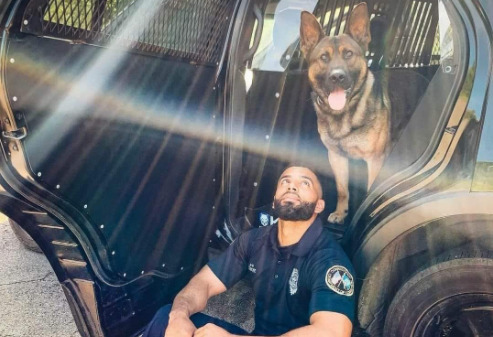
At this point, the anti-police harangues are stale and undeniably baseless. Yet they persist and unrelentingly try to hinder courageous cops who continue to show up to do a job most refuse to do…
Policing today is more arduous than ever before, emphasizing the necessity to rely on one another to survive the shift, return home unscathed, and restore balance.
In that context, there is one staple ingredient in the crime-fighting playbook which always shows up in an anti-cop climate, has zero gripes, exhibits unconditional investments, gladly works for the good of all, and enjoys an occasional chewy or boney treat: police canines.
Indeed, “will work for food” is a most evident trait among all our four-legged police partners, so I guess we can concede that one condition of employment.
Legislative acts have been put on the books, each having specific recognition and protections for our police canines. Some jurisdictions have developed protocols to transport injured police service animals via medical helicopter while others are trying to follow suit.
Albeit a hard pill to swallow, especially after police handler/canine duos become so cemented together in terms of co-reliance and emotional bonds run deep, it is a mainstay that law enforcement dogs typify self-sacrifice and sometimes take a bullet or knife attack or drowning at the hands of miscreants they encounter on the job.
The Officer Down Memorial Page honors fallen police canines, each commemorated for exemplifying law enforcement duties and self-sacrifice in that regard.
The morbid instances whereby police K9s are met with malice and perish in the line of duty are few and far between.
Thankfully, a far greater number of victories and success stories amounting to criminal apprehensions, volumes of drugs seized, gobs of guns discovered/confiscated, and recovered missing/endangered persons are on the books.
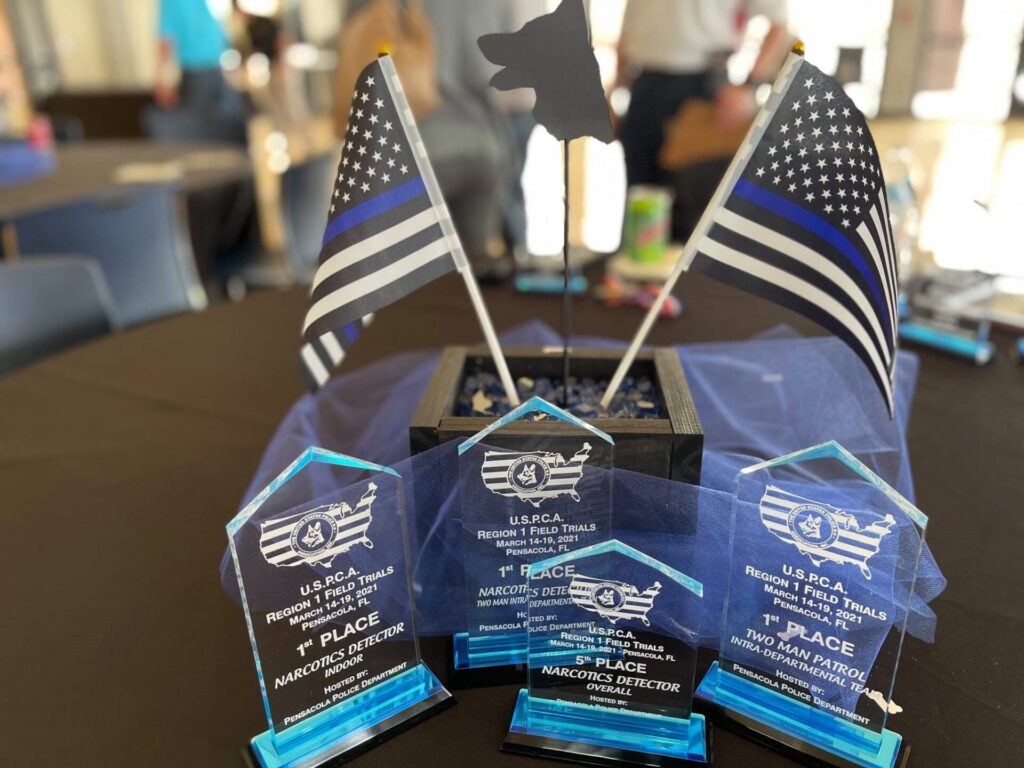
(Awards symbolizing successes of police canine programs and crime-fighting efficacy. Photo courtesy of the Tarpon Springs Police Department.)
So, too, are the partner-saving feats these animals cater. With the increasing rate of police suicides, one additional facet of canines is their organic provisions of therapeutic values not only for stressed police personnel but also for those in the community who can readily relate to the joys dogs bring to victims or shut-ins or anyone in any circumstance.
I keep coming across nuggets whereby varying law enforcement agencies of all sizes in America are adopting in-house self-help programs in which a dog or two is added to the force for the sole purpose of simply being a buddy to any police personnel, the recipe of which is to mend psyches severely impacted by the job. Sort of like athletic teams’ mascots, except not necessarily intended as a goof—then again, that wouldn’t be so bad either, helping to crack the galvanized shell/stigma and allow distressed humanity to defuse.
As a kid growing up in NYC, I always saw the iconic Dalmation in each of the many New York fire houses, often actually riding aboard the engine or whatever apparatus was responding to a call. Didn’t think much of it then, only that it was “cool” to see, but in retrospect I can easily imagine how those black-dotted white dogs sorta served as pseudo-psychologists for the FDNY firefighters who, like cops, encounter some horrific scenes and must process it before the next call. It adds up, and having a stationhouse mascot highly likely mitigated some of the growing angst by public safety professionals.
Yet the NYPD back then didn’t have police canines anywhere near the numbers we have today. Evolution of dogs as police personnel gradually kicked in and greatly aided cops. More and more law enforcement agencies launched police canine units, realizing great success and police lives saved.
It remains true that most suspects surrender when they see/hear a police dog on scene. The number of bold, stupid criminals who gamble against a police dog (“fur missile”) often pay the price; an unrelenting clench eventually registers on a malcontent’s mind.
My department’s inception of a K9 unit swiftly materialized in more wins in terms of suspects nabbed and contraband seized; that continues today. And that is the grand delight of every cop shop which has a canine component among their arsenal of resources to serve the public and cops by pushing back crime and alleviating many of the perils to human counterparts.
Since we are on the subject of cops/canines making dynamic duos, it is not lost on me that many other species of animals seem to find their way into the presence of police officers. On midnight shift, I’ve had a number of encounters with alligators (I’ll ensure “scene safety,” wait for state wildlife cops to arrive), raccoons, possums, (ahem) snakes, armadillos, wayward parrots, cats, guinea pigs, turtles (those snappers can be brutal and odiferous), injured birds of prey, pigs, escaped bulls (what a caper that was), unloosed horses, standoffish chickens, and many more creatures.
As is often said: “The freaks come out at night!” Welp, so do animals, and cops do their darndest to round them up and return them to safe/conducive environments.
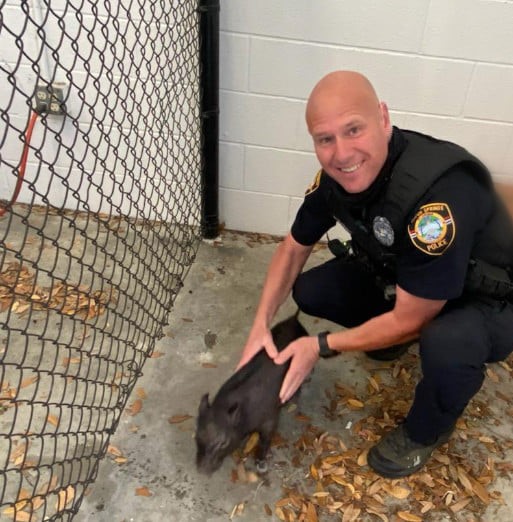
(Photo courtesy of the Tarpon Springs Police Department.)
Although most law enforcement agencies have animal control officers to handle calls regarding animal rescues/aid, cops have a huge heart for species sharing the planet.
Many a moment did I have coming upon stray dogs whose main issues were fear of a fast-paced world and chronic hunger. Heartstrings helped sew together salvation for these creatures by the cops who scooped them up, boarded them into a police cruiser, and set out to get proper aid by professionals practicing veterinary science and/or sheltering, rehabilitation, and adoption objectives, before which were comprehensive attempts to identify a rightful owner.
The Warwick, Rhode Island police department offers us an example of a street save and subsequent efforts by police personnel to reunite a wayward puppy with its rightful owner:
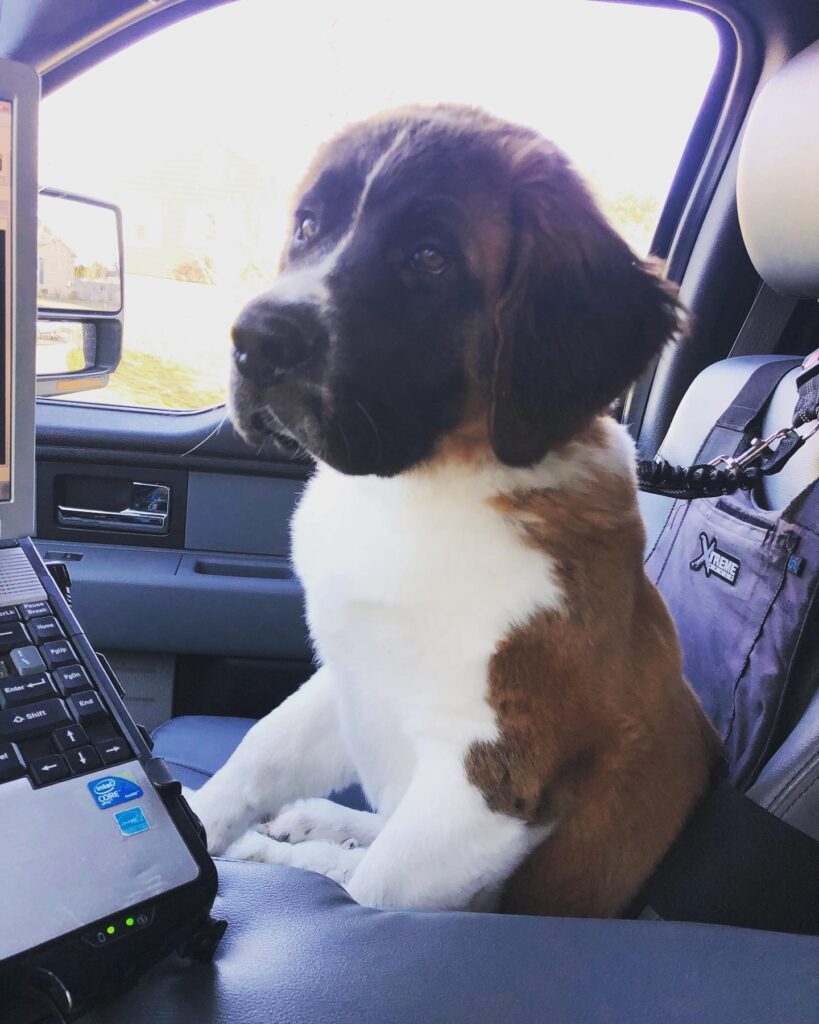
(Photo courtesy of the Warwick Police Department.)
Because midnight shift is on the other side of the clock, opposite when most traditional businesses and services are open, my agency had a make-shift kennel section situated just outside of the exit door of the Communications Center where civilian support personnel received calls for service and dispatched appropriate emergency response vehicles/personnel.
Any street-harvested stray dogs, cats, or whatever animal that patrol officers brought in were carefully tended to by dispatchers until rightful owners could be identified and/or county animal control officers assumed responsibility/custody.
Speaking for myself, animal rescues became a welcomed stress-relief throughout many 12-hour shifts: I imagine it was for my colleagues as well, both sworn and civilian—our unofficial kennels were often occupied, kibble on hand from out-of-pocket LE staff, and many police employees stayed over on their own time to nurture and figure out a way home for these furry finds.
And that brings us back to the point of how certified police dogs (whether active-duty working a beat or at-station mascots providing therapy to public safety personnel distressed by dealing with human deprivation and violence) serve grandly in the context of cops and ultimate success and survival.
The concept of police service animals has achieved wider exposure after garnering massive wins on the street scene involving many battles with evil elements. Conversely, the law enforcement community has suffered some losses of police K9s who went in ahead of humans and “took one for the team.” All of these episodes are chronicled in police agencies, and the line-of-duty-deaths of police dogs killed in action are chiseled in stone at local and national law enforcement memorial sites around America.
Indeed, the fallen police canines are accorded the deep respect and honors equal to that given human counterparts killed in the line of duty.
Police canines are undeniably instrumental in police work, both from a criminal suppression context as well as a viable public relations icon (kids love ‘em even more when they witness their discipline, skill sets, and relationship bonds with assigned handlers).
Throughout my career, I admit I was sometimes partially distracted from eye-balling would-be suspects when our police dogs did their thing: the ultra-discipline and training is spectacular, especially when the dog performs sensory-specialized duties and then silently defers findings to the handler (specific cues denoting something is amiss; a find right near this quarter-panel; someone is holding contraband on their person, etc.), all phenomenal results stemming from an animal desirous of doing good. Like I mentioned earlier, will work for food…but a chewy toy will suffice.
The added therapy bonus for police canine handlers is that universal protocol which denotes the human cop and his/her animal cohort get to go home/reside together when off duty. (I can envision an off-duty cop petting his/her service dog while watching the rancor of anti-law enforcement depictions on TV.)
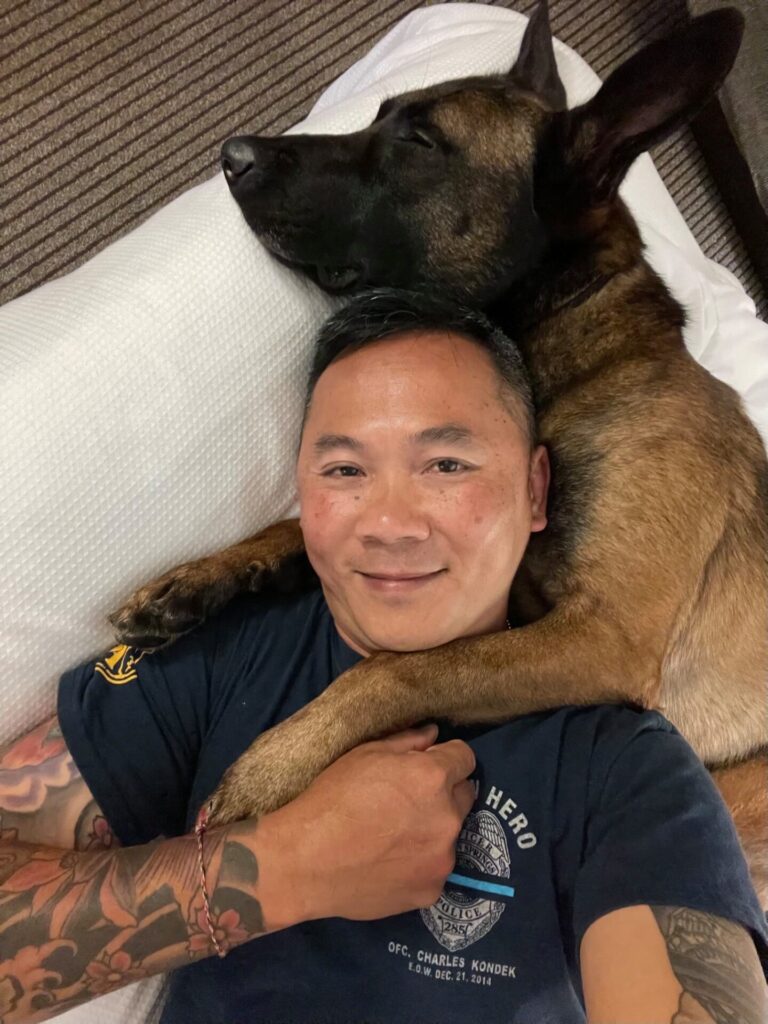
(Police K9 “CK,” named after fallen police Officer Charles Kondek, and his handler, Officer Nguyen, decompressing at home. Photo courtesy of the Tarpon Springs Police Department.)
It is perhaps ironic that while “adults” bark half-baked anti-cop obscenities, youngsters see the reality and enormous value of police officers in terms of the human and canine kind. Some kids even endeavor to market lemonade or launch a non-profit entity with express purposes to raise funds for police canines across the country, proceeds of which are earmarked to purchase police dogs, train them, outfit them with ballistic vests, administer veterinary care, and enable them to perform uniquely qualified heroic deeds.
Similarly, police canine foundations provide financial sustenance for K9 cops and their dogs. The Officer Collin Rose Memorial Foundation raises funds to provide Buddy Bags which “contain emergency canine first aid supplies and an oxygen mask to help handlers render emergency aid should their partner become injured on the job.” Gotta love the symbiotic constructs so prevalent among law enforcement officers…and the private-based sources which help alleviate the public service-funding taxpayers.
As implied in our title above, the police therapy dog concept is growing among the law enforcement community while the constant bark from anti-police snouts wages on with distractions via propaganda.
For National Puppy Day on March 23rd, the Lee County, Florida sheriff’s office posted the following image of Sheriff Carmine Marceno snuggling with a puppy which seemingly melted into a safe harbor. The sheriff’s office post reiterated, “The Lee County Sheriff’s Office continuously works to protect those who cannot protect themselves” and encouraged folks to “give your fur-family lots of love today [and everyday]!”
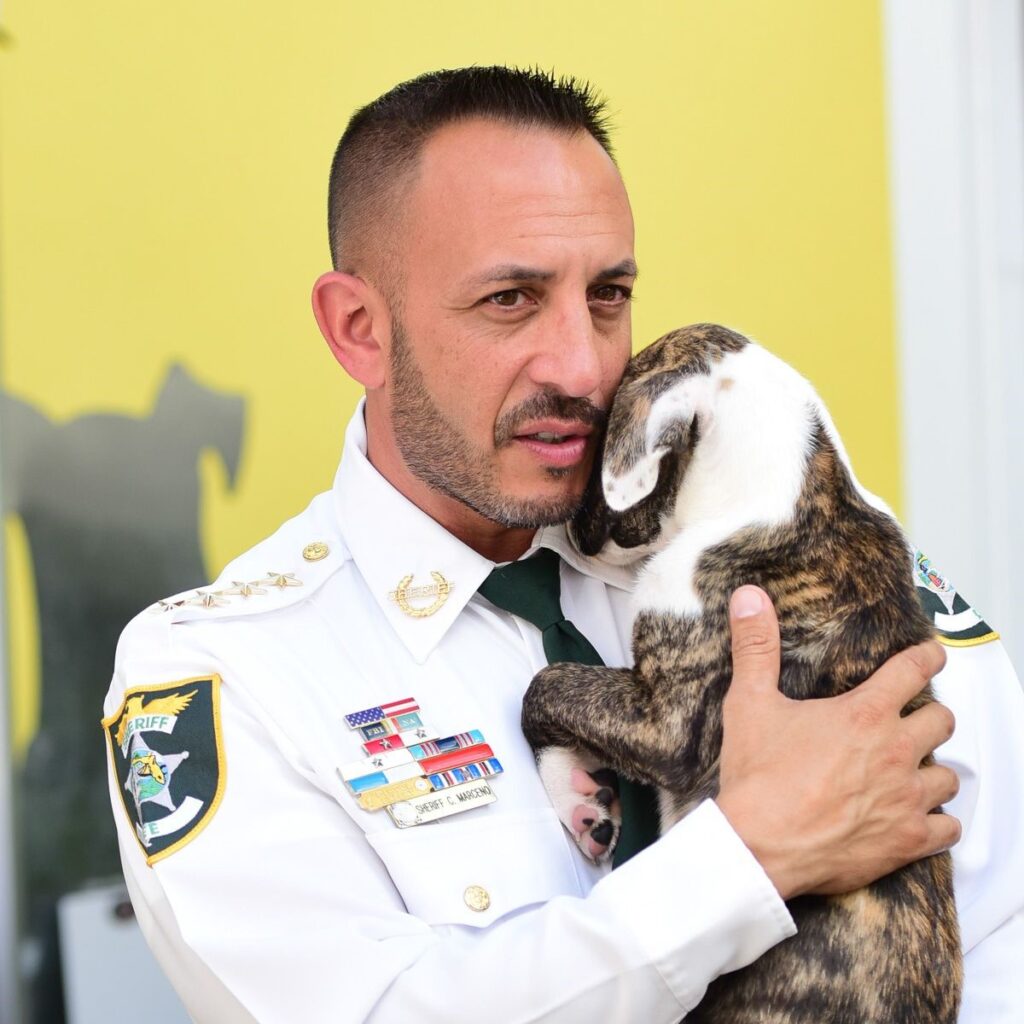
(Photo courtesy of the Lee County Sheriff’s Office.)
There you have it; that about sums it up.
Between the dregs and the dogs, I’ll partner with the pawsomeness of canine cops any day.